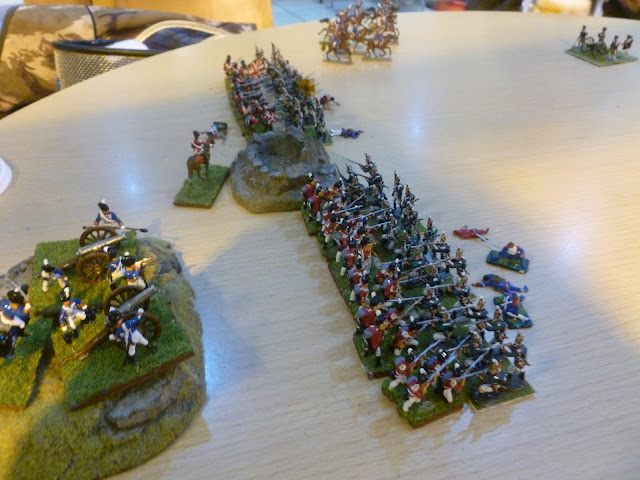The 11:55am, 29th January saw a Russian army commanded Brigadier Roman advancing on Tomio. Blantyre's force formed a line two deep along a ridge running north wards only a few miles to the east of the town.
Lord Blantyre's expeditionary force
Two companies: thirty eight men, one sergeant Colour's ensign, piper and drummer.
-16th Bedfordshire regiment of foot, 1st company.
one company: twenty men, two musicians and two sergeants
-Royal Horse artillery, two 8pdrs.
five crewmen and one master gunner
Brigadier Roman's invasion force
two troops: seven lancers, five troopers and two captains
-Pavlov grenadiers, 1st and 2nd companies
two companies: forty four men, colour ensign, Captain, fifer and drummer
-Foot artillery, two 6pdrs
ten crewmen, two master gunners and a caisson
The battle commenced at 12:13 and lasted precisely eighteen minutes.
Command of the British army was divided between Lord Blantyre, commanding the infantry holding the ridge, and Major Hugo Parkhill of the Royal horse artillery, in command of the battery on the rocky knoll just a bit back from the thin red line.
As the Russian infantry prepared to advance up the hill in lines similar to those used by their opponents, Parkhill's battery opened fire upon the 2nd company. However only one of the roudshots hit, the other flying long but narrowly missing brigadier Roman, slicing through the ranks to send a man soaring. However being the steady Pavlov grenadiers of the mitre cap they resolutely ignored the barrage.
It was now that the Russian army came on in earnest, the 2nd company of grenadiers marching staunchly up the ridge to within musket range, whilst the 1st charged towards their foes, only stopping when the order to open fire reached them.
On the British right one of the troops of Don Cossacks charged up the flank of the line and swept to attack the 42nd light company, who quickly formed square to deliver closing fire. On the left the cossacks penetrated round the back of the British lines, heading towards Parkhill's battery.
The 1st company of Russian grenadiers now opened fire, their muzzles almost touching those of their foes, but most of the shots misfired and many missed entirely, the 42nd suffering only minor casualties.
The Cossacks, armed with lances, perfect for square busting!, thrusted and shot at the highlanders trying to break through their firm ranks. But the highlanders returned as good as they got, firing off their muskets at close range upon the cavalrymen. In the end the cossacks broke, having taken heavy casualties from the redcoats and completely unable to break the square. However the highlanders had also sustained heavy losses and thus, fearing that they had ceased to be effective as a fighting force, they too retired from the field.
The Russian artillery, readily supplied by their ammunition caisson and under the scrutiny of the brigadier, opened fire on their opposing battery, their troops all having just charged into combat. But the elevation was two high for the 6pdrs to meet and the shots all failed to hit.
The British artillery, ignoring the failing Russian cannons, opened fire at quite close range upon the remaining Cossacks charging towards them. The shots tore through their ranks and halted the cavalrymen in their tracks.
The Cossacks fled back behind their own lines to attempt to rally themselves, whilst the 42nd grenadiers opened fire on the Pavlovs, causing considerably more damage upon the Russians then they had received themselves.
The Russians, unable to shift the red coated soldiers from the ridge through simple musketry, charged into combat. A long line formed across the bridge as bayonets hacked and stabbed away through the smoke.
On the right the Pavlov grenadiers came off considerably worse than the 16th Bedfords, suffering double the casualties of the redcoats, and eventually to cheers of Britannia the Russians bolted down the slope as fast as they could, tearing off after the fleeing Cossacks.
The combat was over and on the right the Bedfords were victorious, having only fought native tribesmen for the last few decades, now they had seen off Russia's elite. But on the left the Pavlov first company, colours flying, saw off the 42nd grenadiers, their colours still held aloft as they scattered from the field. Here the battle ended, both sides ground down to a stalemate. The 16th prepared to fall back on the knoll and make their stand, but the Russians were too sane to push on. The British still held the ridge, but were in no position to follow up their victory and push the Russians back. It was a sour ending and Tomio would yet again be a battlefield
















